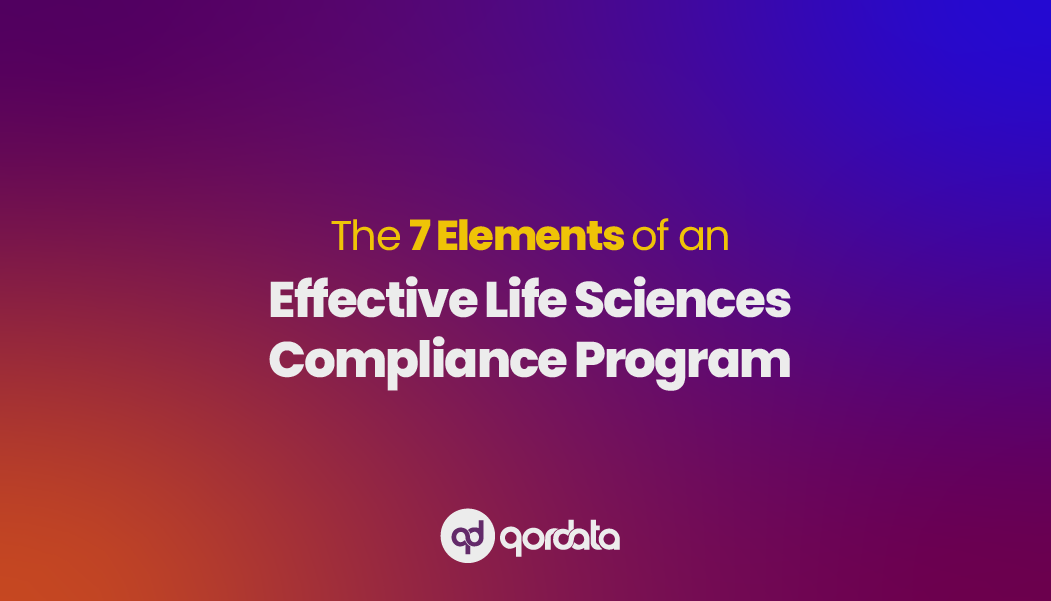We perform gap assessments in our daily lives without even realizing it. Take, for example, the simple act of meal planning.
When planning a meal, you decide what you will eat, identify the necessary ingredients, check what you already have in your kitchen, and then list the necessary items. A trip to the grocery store follows to purchase these missing ingredients.
In the life sciences industry, compliance gap assessment follows a similar pattern. It involves evaluating an organization’s current state of compliance and setting the desired state to achieve. The difference between these two states highlights the gaps that must be addressed.
Once identified, the gaps should be documented, shared with the relevant stakeholders, and remedied by the appropriate personnel to ensure regulatory adherence and enhance the effectiveness of a compliance program.
Simply put, the desired state in meal planning is having all the ingredients needed for your meal, and the gaps are the ingredients you don’t have.
This concept is mirrored in compliance gap assessment, where achieving the desired state of compliance is akin to having all the necessary components for a successful, compliant operation.
The documentation of gaps is akin to your grocery list, and remediation is comparable to your trip to the store to acquire the missing ingredients.
The Three Uses Of A Gap Assessment
Compliance gap assessment has been proven valuable in various scenarios as it provides compliance professionals with actionable and valuable insights that can be leveraged to improve compliance programs.
Let’s delve into the top three use cases of compliance gap assessments, demonstrating their versatility and effectiveness.
1. Determine Whether The Compliance Program Is Adequately Designed
As stated in the U.S. Department of Justice (DOJ) manual, “Critical factors in evaluating any program are whether the program is adequately designed for maximum effectiveness in preventing and detecting wrongdoing by employees and whether corporate management is enforcing the program or is tacitly encouraging or permitting employees to engage in misconduct.”
Additionally, the DOJ advises prosecutors to evaluate the comprehensiveness of compliance programs to determine their effectiveness.
While the Evaluation of Corporate Compliance Program guidance emphasizes the importance of risk assessments for determining effectiveness, an essential preliminary step is conducting a compliance gap assessment.
Given the unique nature of each organization and its specific challenges and requirements, a compliance program adequately designed for one organization might not be adequately designed for another.
Conducting a compliance gap assessment allows for identifying disparities between regulatory requirements, challenges, and other integral aspects of your existing compliance program.
Remediating the gaps identified through compliance gap assessment augments the capabilities of your compliance controls, ensuring effective operation.
Additionally, subsequent risk assessments can confirm that the remediations align with your organization’s distinct needs and can address risks before they escalate to critical levels.
2. Analyze Regulatory Changes and Enhancing Compliance Preparedness
Failure to adapt to new rules and regulations can expose an organization to critical risks and legal implications, making proactive compliance essential. A compliance gap assessment is a strategic tool during regulatory flux.
It empowers compliance professionals to document existing requirements, evaluate the adequacy of current strategies in addressing evolving compliance demands, and pinpoint areas that necessitate modification to align with new regulatory mandates.
Usually, compliance processes and functions are designed to respond to changes in rules and regulations. A gap assessment sheds light on these adaptive mechanisms within your organization.
Not only do you understand the intricacies of these adaptive processes, but you also identify their lacking. The newfound understanding enables you to determine key risk areas where remediations are imperative, ensuring regulatory adherence to evolving rules and regulations.
3. Enhance A Compliance Program’s Maturity Level
A compliance maturity model assesses the capabilities of a compliance program in identifying, remediating, and reducing compliance risks to safeguard the organization from legal and reputational risks.
Within compliance maturity models, various levels exist, characterized by terminology ranging from ad hoc to incomplete to optimized, representing different stages of compliance program development and effectiveness.
-
Ad-hoc or Incomplete Compliance Programs: These lack formalization and essential capabilities to address critical risks efficiently.
-
Optimized Compliance Programs: These operate in a state of continuous improvement, proactively handling compliance risks while anticipating future needs.
Conducting a maturity model gap assessment involves defining the desired level of maturity and evaluating where your current program stands within the compliance maturity model framework.
By identifying and understanding the gaps between the two states, you can strategically enhance your compliance program’s maturity through targeted remediation efforts.
Conducting A Compliance Gap Assessment
Compliance is not one-size-fits-all, particularly in the life sciences industry. Hence, conducting a compliance gap assessment in this industry would require a customized approach tailored to the organization’s distinctive structure, specific challenges, and industry demands.
Let’s discuss the different phases involved in conducting a gap assessment.
Phase 1: Planning a Compliance Gap Assessment
Planning is essential before conducting a gap assessment, and it consists of various stages:
-
Defining the assessment scope and framework
-
The gap assessment methodology
-
Identifying key resources and engaging stakeholders
-
Creating a comprehensive project plan
-
Defining roles and responsibilities
-
Establishing effective lines of communication
Defining the Assessment Scope and Framework
Setting the right scope is fundamental before commencing a compliance gap assessment within the life sciences industry. The scope delineates what aspects will be evaluated and which business units will be scrutinized.
For instance, ensuring compliance with regulations like the Foreign Corrupt Practices Act, Anti-Bribery Anti-Corruption, and Anti-Kickback/Stark Laws is critical.
This phase aims to clarify if the assessment will cover the entire organization or if a phased approach, examining one business unit at a time, would be more practical, especially for larger organizations.
Moreover, selecting an appropriate assessment framework is essential. For instance, leveraging established guidelines like the U.S. Department of Justice’s Evaluation of Corporate Compliance Programs can provide a structured foundation for evaluation.
Defining the framework in this phase establishes a roadmap for the assessment.
Crucially, this initial clarity mitigates ‘scope creep,’ an unwanted expansion of assessment parameters during the evaluation.
Preventing scope creep is vital to ensure that resources and time remain in check, aligning with the requirements and pace of the life sciences industry.
The Gap Assessment Methodology
Choosing the right methodology is critical when embarking on a compliance gap assessment within the life sciences industry.
This methodology encompasses the procedures and approaches specific to the assessment, providing the structure for the identification, investigation, and assessment phases.
Additionally, the methodology outlines how information will be gathered through interviews, documentation review, previously experienced compliance challenges, remediated risks, key risk areas, or other means, ensuring an efficient and aligned data acquisition process.
This phase also assists in estimating the assessment duration and contributes significantly to developing a robust compliance gap assessment plan.
Identifying Key Resources and Engaging Stakeholders
This step involves identifying subject matter experts (SMEs) within the organization who possess in-depth knowledge of current processes.
Optimal insight is gained by including a mix of non-management and management personnel, enabling a comprehensive understanding of existing procedures.
For instance, if the assessment focuses on compliance with the Physician Payment Sunshine Act, pinpoint the departments responsible for financial operations, legal compliance, regulatory affairs, marketing, and interactions with healthcare professionals.
Identifying these key departments ensures the assessment encompasses a complete view of the compliance landscape.
Furthermore, understanding the scope of the assessment helps delineate the stakeholders involved, encompassing SMEs, management, and senior or executive management.
This stakeholder engagement ensures alignment, comprehensive insights, and effective assessment processes.
Creating a Comprehensive Project Plan
A well-structured project plan is critical in effectively organizing a compliance gap assessment. The formal document would outline the assessment process, including tasks, timelines, and allocated resources involving various departments or personnel.
Additionally, it’s advantageous to estimate the time required for each task and phase, whether in hours or days, aiding in efficient resource allocation and scheduling.
The plan incorporates crucial milestone dates to ensure the assessment remains on track.
Defining Roles and Responsibilities
Clearly defining the roles and responsibilities of the team involved is a crucial aspect of planning a compliance gap assessment.
This documentation covers the roles of assessors, individuals responsible for compliance monitoring and remediation, and upper management.
On the other hand, responsibilities involve scheduling meetings, creating requirements, generating comprehensive reports, communicating remediation needs to the concerned professionals, executing remediation tasks, and monitoring the progress to ensure timely completion.
While using a RACI (Responsible, Accountable, Consulted, Informed) chart is a helpful tool to document and define roles and responsibilities, its application may vary based on the organization’s specific requirements and practices.
Establishing these roles and responsibilities during the planning phase is fundamental for a seamless and effective gap assessment process, regardless of the approach.
Establishing Effective Lines of Communication
This plan should outline how communication will keep key stakeholders informed, the frequency of updates, and the level of detail that will be shared.
Due to the diverse information-sharing cultures within life sciences organizations, it’s vital to customize the communication methods and frequency accordingly.
Providing high-level project plans with milestone dates to management, senior executives, and other relevant stakeholders grants them transparency into the project’s progression.
Organizations often opt to publish the project plan and subsequent updates on shared drives or internal data storage systems where appropriate.
This practice enhances accessibility, ensuring stakeholders and other resources can access and review the information as needed, fostering collaboration and informed decision-making.
Phase 2: Identification of Compliance Requirements
In this phase, you can uncover compliance requirements that will eventually form the backbone of your organization’s compliance framework.
To begin, it’s vital to identify and articulate compliance requirements. This involves a deep dive into regulatory guidelines, industry standards, organizational policies and operations, and other mandates governing your business.
Picture these requirements as the essential ingredients needed for a perfect recipe; each one contributes to the overall flavor and quality of the dish.
Keep in mind that understanding these requirements is only the first step. We need to discern their applicability within the unique context of your organization.
Hence, evaluate how each requirement aligns with your organizational structure, operational processes, and overarching compliance objectives.
In your quest for clarity, never hesitate to contact Subject Matter Experts (SMEs). A meeting with an SME can help you understand the complex regulatory nuances and offer a roadmap to navigate this phase effectively.
Another pro tip to successfully pull this phase off would be documentation. Documenting the requirements provides a solid reference point and supports effective collaboration within your compliance team.
Whether on a spreadsheet, in a detailed document, or using specialized compliance software, the key is to capture each requirement accurately and comprehensively.
The output of this phase is not merely a collection of compliance requirements. It’s a blueprint of your desired state – the compliance zenith your life sciences company aims to achieve.
Phase 3: Investigating Current Compliance Status
An investigation would determine how your organization currently adheres to compliance requirements enacted by the regulatory authorities.
What policies, compliance monitoring procedures, processes, or documentation are currently in place? Are they capable of addressing compliance challenges?
While investigating, document the current compliance state in a system or spreadsheet where the requirements were documented during the identification phase.
Review the requirements and the current compliance state before conducting interviews with SMEs.
Not only will this give you a strong understanding of the requirements, but you’ll also be able to steer the meetings in the right direction and showcase your preparedness.
Acquire all information, such as policies and procedures documents, and assess them thoroughly so that you completely understand the current state of compliance (how the organization is adhering to the requirements identified in Phase 2.)
Phase 4: Assessing Compliance Requirements with the Current State
Compare the compliance requirements identified in Phase 2 with the information learned about the current compliance state of the organization in Phase 3.
The differences you identify while comparing the requirements with the current state will be documented as gaps.
You can also document recommendations for remediation of the gaps identified in this phase. The objective is to provide a clear way forward to the organization’s upper echelon to ensure compliance with regulatory requirements.
One thing that may come out of the blue is that organizational leaders may ask you to assign a risk severity score so that they can prioritize risk remediations.
Since gap assessment is not designed to assess risk severity, it’s up to you to decide whether to include risk severity scores.
Unless a comprehensive risk assessment is performed, it would be best if your report could clearly state that the purpose of conducting the gap assessment was to identify gaps and not assess risk severity. The risk severity scores in the report are based on estimation to help prioritize remediations.
The output of Phase 4 is comparing the desired state with the current state to identify gaps and provide remediation recommendations.
Phase 5: Preparing A Compliance Gap Assessment Report
It is time to accurately and efficiently prepare a gap assessment report that presents the findings, information, remediation recommendations, and conclusions uncovered while conducting a compliance gap assessment.
Other integral components of the report include the following:
-
Executive summary
-
Purpose
-
Scope
-
Methodology
-
Current compliance state
-
Findings summary
-
Regulatory changes and updates
-
Detailed findings
-
Root cause analysis
-
Desired compliance state
-
Risk scoring (Optional)
-
Risk mitigation strategies
-
Action plan
-
Budget allocation
-
Conclusion
What else can you add to make your report rise to the occasion? Include graphs with data trends to draw viewers’ attention to key compliance focus areas.
In the appendix, provide all the sources of information that were reviewed to conduct the compliance gap assessment.
Moreover, the detailed findings should also include the areas where no gaps were identified or the requirements that were determined not to be applicable.
Phase 6: Effectively Remediating Compliance Gaps
In the case of compliance, remediation refers to addressing and correcting identified issues, deficiencies, or non-compliance areas within an organization to align with established regulations, policies, or desired standards.
By conducting a comprehensive compliance gap assessment, we clearly understand the organization’s current compliance state and the desired state of compliance that the organization aims to achieve.
In the 1st phase, we also discussed assigning roles and responsibilities to specific individuals or departments. In this phase, you can allocate a designated person or department to steer the remediation effort. The assigned personnel must tailor solutions that align with the specifics of each identified gap.
It’s like mending a piece of fabric – you choose the right stitch and pattern for each tear. However, we acknowledge that not all gaps can be instantaneously resolved.
Some might persist due to complexity, resource constraints, or strategic decisions. Here’s where a prudent approach is crucial. For these lingering gaps, a clear strategy is needed.
This is also where their prowess and dedication come to the forefront. Each gap is unique, and so is its remedy.
Conclusion
In life sciences compliance, where adherence to regulations is paramount, untreated gaps can be akin to risks. They represent potential points of vulnerability in our compliance armor.
So, it’s vital to manage these untreated gaps meticulously. Treat them as you would a critical patient, with a precise diagnosis and a tailored treatment plan.
Consider categorizing them based on their nature and potential impact. Are there contractual gaps? Are they regulatory deviations?
Assess their potential risk level and devise mitigation strategies accordingly. This might involve bolstering other areas of compliance to compensate or allocating additional resources to address these gaps promptly.
Takeaways
-
Compliance gap assessment mirrors meal planning, identifying missing “ingredients” in regulatory adherence.
-
Three critical uses of a gap assessment: evaluate program design, adapt to regulatory changes, and enhance compliance program maturity level.
-
Phases of conducting a gap assessment: planning, identifying compliance requirements, investigating current compliance status, assessing compliance with the current state, preparing a comprehensive report, and effectively remediating compliance gaps.
-
Effective remediation involves assigning roles, tailoring approach, and strategically addressing identified gaps.
-
Managing compliance gaps is crucial in the life sciences industry to prevent potential risks, categorize gaps, and devise appropriate mitigation strategies.



